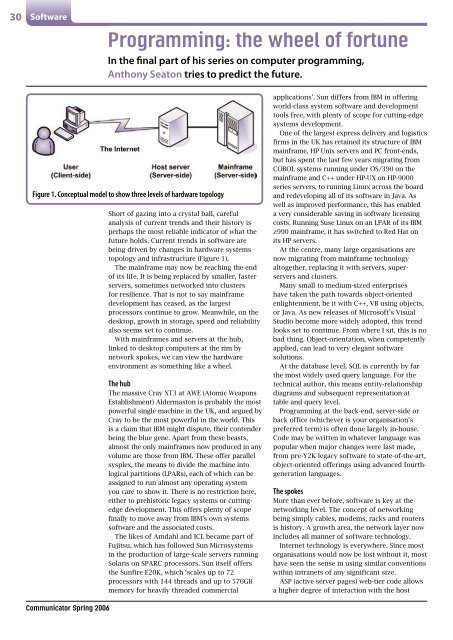S1000D-compliant illustrations - ISTC
S1000D-compliant illustrations - ISTC
S1000D-compliant illustrations - ISTC
Create successful ePaper yourself
Turn your PDF publications into a flip-book with our unique Google optimized e-Paper software.
30 Software<br />
Programming: the wheel of fortune<br />
In the final part of his series on computer programming,<br />
Anthony Seaton tries to predict the future.<br />
Figure 1. Conceptual model to show three levels of hardware topology<br />
Short of gazing into a crystal ball, careful<br />
analysis of current trends and their history is<br />
perhaps the most reliable indicator of what the<br />
future holds. Current trends in software are<br />
being driven by changes in hardware systems<br />
topology and infrastructure (Figure 1).<br />
The mainframe may now be reaching the end<br />
of its life. It is being replaced by smaller, faster<br />
servers, sometimes networked into clusters<br />
for resilience. That is not to say mainframe<br />
development has ceased, as the largest<br />
processors continue to grow. Meanwhile, on the<br />
desktop, growth in storage, speed and reliability<br />
also seems set to continue.<br />
With mainframes and servers at the hub,<br />
linked to desktop computers at the rim by<br />
network spokes, we can view the hardware<br />
environment as something like a wheel.<br />
The hub<br />
The massive Cray XT3 at AWE (Atomic Weapons<br />
Establishment) Aldermaston is probably the most<br />
powerful single machine in the UK, and argued by<br />
Cray to be the most powerful in the world. This<br />
is a claim that IBM might dispute, their contender<br />
being the blue gene. Apart from these beasts,<br />
almost the only mainframes now produced in any<br />
volume are those from IBM. These offer parallel<br />
sysplex, the means to divide the machine into<br />
logical partitions (LPARs), each of which can be<br />
assigned to run almost any operating system<br />
you care to show it. There is no restriction here,<br />
either to prehistoric legacy systems or cuttingedge<br />
development. This offers plenty of scope<br />
finally to move away from IBM’s own systems<br />
software and the associated costs.<br />
The likes of Amdahl and ICL became part of<br />
Fujitsu, which has followed Sun Microsystems<br />
in the production of large-scale servers running<br />
Solaris on SPARC processors. Sun itself offers<br />
the Sunfire E20K, which ‘scales up to 72<br />
processors with 144 threads and up to 576GB<br />
memory for heavily threaded commercial<br />
applications’. Sun differs from IBM in offering<br />
world-class system software and development<br />
tools free, with plenty of scope for cutting-edge<br />
systems development.<br />
One of the largest express delivery and logistics<br />
firms in the UK has retained its structure of IBM<br />
mainframe, HP Unix servers and PC front-ends,<br />
but has spent the last few years migrating from<br />
COBOL systems running under OS/390 on the<br />
mainframe and C++ under HP-UX on HP-9000<br />
series servers, to running Linux across the board<br />
and redeveloping all of its software in Java. As<br />
well as improved performance, this has enabled<br />
a very considerable saving in software licensing<br />
costs. Running Suse Linux on an LPAR of its IBM<br />
z990 mainframe, it has switched to Red Hat on<br />
its HP servers.<br />
At the centre, many large organisations are<br />
now migrating from mainframe technology<br />
altogether, replacing it with servers, superservers<br />
and clusters.<br />
Many small to medium-sized enterprises<br />
have taken the path towards object-oriented<br />
enlightenment, be it with C++, VB using objects,<br />
or Java. As new releases of Microsoft’s Visual<br />
Studio become more widely adopted, this trend<br />
looks set to continue. From where I sit, this is no<br />
bad thing. Object-orientation, when competently<br />
applied, can lead to very elegant software<br />
solutions.<br />
At the database level, SQL is currently by far<br />
the most widely used query language. For the<br />
technical author, this means entity-relationship<br />
diagrams and subsequent representation at<br />
table and query level.<br />
Programming at the back-end, server-side or<br />
back office (whichever is your organisation’s<br />
preferred term) is often done largely in-house.<br />
Code may be written in whatever language was<br />
popular when major changes were last made,<br />
from pre-Y2K legacy software to state-of-the-art,<br />
object-oriented offerings using advanced fourthgeneration<br />
languages.<br />
The spokes<br />
More than ever before, software is key at the<br />
networking level. The concept of networking<br />
being simply cables, modems, racks and routers<br />
is history. A growth area, the network layer now<br />
includes all manner of software technology.<br />
Internet technology is everywhere. Since most<br />
organisations would now be lost without it, most<br />
have seen the sense in using similar conventions<br />
within intranets of any significant size.<br />
ASP (active server pages) web-tier code allows<br />
a higher degree of interaction with the host<br />
Communicator Spring 2006






